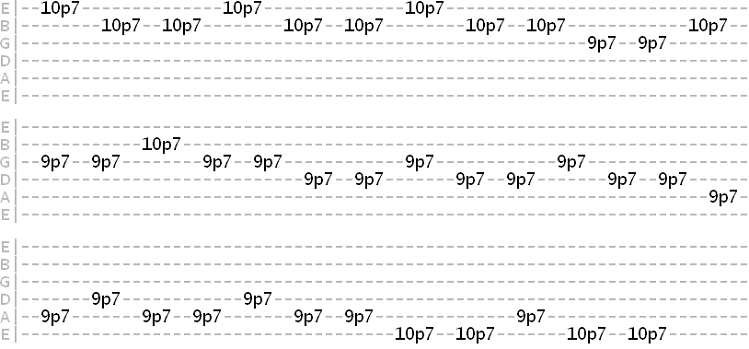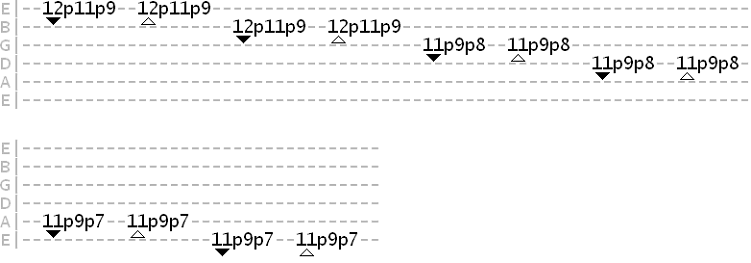Home > Lead >
Pull Off Exercises
As you start to incorporate legato (of which pull offs play an integral part) into your lead phrases, you'll be able to play faster and more fluidly, no longer limited by how fast you can pick. As you'll hopefully realise by the end of this lesson, pull offs are one of the key elements for playing at speed.
Don't forget to start slow and speed up gradually using a metronome.
For the following exercise, I'm going to use the following familiar pentatonic pattern...
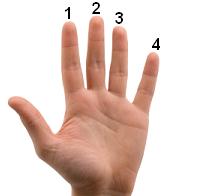
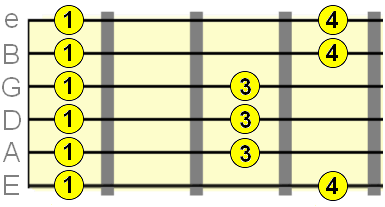
Note that this pattern can be used for both minor and major pentatonic. For minor, use the index (1) finger position on the E strings as the root. For major, use the 4th finger position on the E strings for the root.
We'll start by using two pull offs per string as demonstrated in the below video...
So the sequence will go like this: pick - pull off - pick - pull off - pick - pull off - etc.
In the below tab, the symbol
means "down pick" and the
symbol
means "down pick" and the  symbol
means "up pick". So we're using alternate picking as usual,
but between each pick is a pull off, effectively halving the
number of picks that need to be made.
symbol
means "up pick". So we're using alternate picking as usual,
but between each pick is a pull off, effectively halving the
number of picks that need to be made.
The above example uses the B minor / D major pentatonic scale, but the pattern is, of course, movable depending on the key in which you're playing.
Don't forget to work on the same exercise moving up the pattern.
Now, we need to get all our fingers involved in pulling off. The below exercise uses the phrygian dominant scale in a stepped pattern, but we're still applying exactly the same pick - pull - pick - pull sequence as before.
Learn the fingering for this pattern before you tackle the tab.

OK, let's push things up a notch. We're now going to play more of a "staggered" sequence by moving back and forth between string pairings.
Going back to the pentatonic pattern from earlier, take a look at the below exercise...
Once up to a decent speed (use a metronome!), that's more like something we might use in a solo.
Try coming up with your own 2 string pull off exercises using scale patterns you know.
Let's start with a typical 3.n.p.s. major scale pattern...
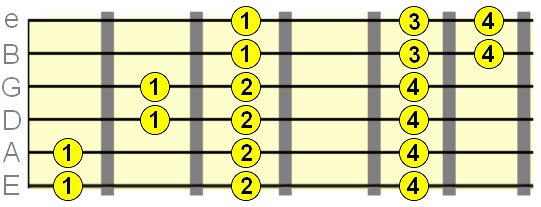
Again, learn the fingering for that pattern before you work on the exercises. You only have to learn it once and you'll likely be using it throughout your entire guitar playing life!
We're going use exactly the same technique as earlier - pulling off the sequence of three notes on each string twice. But instead of picking once every two notes as before, we're picking once every three notes.
So, the sequence is now: pick - pull - pull - pick - pull - pull - pick - pull - pull - etc. as demonstrated in the below video...
Remember, each pick is alternated: down - up - down - up etc. to economise movement.
Here's how we would play that with the root of the scale on B...
And working back up, simply reverse the sequence.
Once we've mastered that, it's time to make the sequence a little more interesting by staggering it in different ways. For example...
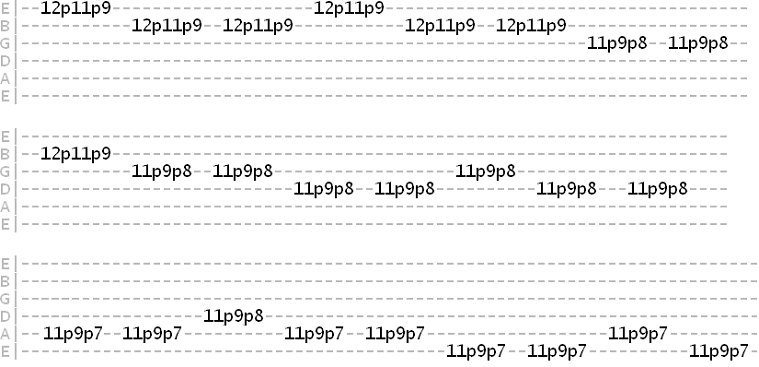
These legato runs will sound better and better as you speed up. Take your time and only touch the BPM on the metronome when you can play confidently at the current tempo.
The other way to play three notes per string patterns is to use what is known as a pedal note or pedal point. This means we're now pulling off to the same note on each string from different notes. Not easy to put into words, so take a look at the below video for a demonstration of how this would play out on the high E string...
So we're pulling off to the lowest note on the string, alternating between the higher notes.
We're back to picking every other note for this: pick - pull - pick - pull - pick - pull - etc.
You could just repeat a single string phrase like that, but let's try incorporating this pedal technique into a larger phrase as follows...

That would work great as a bluesy lick in the key of G#/Ab. You should of course also try it on lower string pairings (B-G, G-D etc.).
Let's apply this pedal technique to the major scale pattern from earlier...
In fact, we can chromaticise this type of sequence and create a very effective warm up exercise...

Move up and down the sequence across all 6 strings.
Also, try different fingering combinations. For example, the above was: 4p1 3p1 2p1...
...so this time let's try: 3p1 4p1 2p1

A prime example of this is to pull off between two notes on one string and then play the 3rd note on a string above or below.
In the example below, we're using the usual pick - pull - pick - pull pattern, but we need to think about economising our picking to allow for playing at greater speed. I've again marked on the pick strokes, and you can see how we start with an up stroke so we're picking in the direction of travel, to the string below.
Obviously you can play something similar on other string pairings. Unfortunately I can't show you every possible variation!
What if the "pulled-off" note is on the same fret as the 3rd note in the triplet?...
We can use a barre technique to cover both those strings. Let's say the string pairing was E and B. Here's how we would play it...
So you can see that once I have picked and pulled off the string, the index finger is in place to "catch" it.
But the index finger is also in place to pick the note on the string directly beneath it. This completes the triplet phrase.
This positioning works for any string pairing.
Let's look at this technique being used in licks, starting with a simple minor arpeggio (use the same picking as before)...

We can also combine this nicely with the pedal technique, alternating the note we pull off from...
Now, I could provide a thousand and one examples, but I think we now have some solid foundation pull off techniques to work on and build our own exercises from.
Try combining the techniques we've looked at, as one large legato phrase or mixed with regular picked scale phrases. The more you mix it up and challenge yourself, the more confident and technical your playing will start to become.
I hope this lesson has given you the speed boost you need for your lead playing!
Guitar Interval Exercises
Hammer Ons and Pull Offs
More Lead Guitar Lessons
Guitar Pull Off Exercises for Faster Soloing
In the introductory guitar pull off lesson, we learned how to apply the basic pull off technique. This lesson will provide you with some more challenging pull off exercises to help really set in that muscle memory and prepare you for applying pull offs in your licks and solos.As you start to incorporate legato (of which pull offs play an integral part) into your lead phrases, you'll be able to play faster and more fluidly, no longer limited by how fast you can pick. As you'll hopefully realise by the end of this lesson, pull offs are one of the key elements for playing at speed.
Don't forget to start slow and speed up gradually using a metronome.
2 notes per string pull off exercises
Many soloing phrases involve a repeating sequence of pull offs using only two notes per string.For the following exercise, I'm going to use the following familiar pentatonic pattern...


Note that this pattern can be used for both minor and major pentatonic. For minor, use the index (1) finger position on the E strings as the root. For major, use the 4th finger position on the E strings for the root.
We'll start by using two pull offs per string as demonstrated in the below video...
So the sequence will go like this: pick - pull off - pick - pull off - pick - pull off - etc.
In the below tab, the
 symbol
means "down pick" and the
symbol
means "down pick" and the  symbol
means "up pick". So we're using alternate picking as usual,
but between each pick is a pull off, effectively halving the
number of picks that need to be made.
symbol
means "up pick". So we're using alternate picking as usual,
but between each pick is a pull off, effectively halving the
number of picks that need to be made.The above example uses the B minor / D major pentatonic scale, but the pattern is, of course, movable depending on the key in which you're playing.
Don't forget to work on the same exercise moving up the pattern.
Now, we need to get all our fingers involved in pulling off. The below exercise uses the phrygian dominant scale in a stepped pattern, but we're still applying exactly the same pick - pull - pick - pull sequence as before.
Learn the fingering for this pattern before you tackle the tab.

OK, let's push things up a notch. We're now going to play more of a "staggered" sequence by moving back and forth between string pairings.
Going back to the pentatonic pattern from earlier, take a look at the below exercise...
Once up to a decent speed (use a metronome!), that's more like something we might use in a solo.
Try coming up with your own 2 string pull off exercises using scale patterns you know.
3 notes per string pull off exercises
For most seven note (heptatonic) scales, your legato playing will involve three notes per string. This is more physically demanding for your fingers, but like with anything you just need to practice and build up speed gradually, ideally using the metronome.Let's start with a typical 3.n.p.s. major scale pattern...

Again, learn the fingering for that pattern before you work on the exercises. You only have to learn it once and you'll likely be using it throughout your entire guitar playing life!
We're going use exactly the same technique as earlier - pulling off the sequence of three notes on each string twice. But instead of picking once every two notes as before, we're picking once every three notes.
So, the sequence is now: pick - pull - pull - pick - pull - pull - pick - pull - pull - etc. as demonstrated in the below video...
Remember, each pick is alternated: down - up - down - up etc. to economise movement.
Here's how we would play that with the root of the scale on B...
And working back up, simply reverse the sequence.
Once we've mastered that, it's time to make the sequence a little more interesting by staggering it in different ways. For example...

These legato runs will sound better and better as you speed up. Take your time and only touch the BPM on the metronome when you can play confidently at the current tempo.
The other way to play three notes per string patterns is to use what is known as a pedal note or pedal point. This means we're now pulling off to the same note on each string from different notes. Not easy to put into words, so take a look at the below video for a demonstration of how this would play out on the high E string...
So we're pulling off to the lowest note on the string, alternating between the higher notes.
We're back to picking every other note for this: pick - pull - pick - pull - pick - pull - etc.
You could just repeat a single string phrase like that, but let's try incorporating this pedal technique into a larger phrase as follows...

That would work great as a bluesy lick in the key of G#/Ab. You should of course also try it on lower string pairings (B-G, G-D etc.).
Let's apply this pedal technique to the major scale pattern from earlier...
In fact, we can chromaticise this type of sequence and create a very effective warm up exercise...

Move up and down the sequence across all 6 strings.
Also, try different fingering combinations. For example, the above was: 4p1 3p1 2p1...
...so this time let's try: 3p1 4p1 2p1

Triplet pull off exercises
A triplet is a (most often quickly played) succession of 3 notes. We can play these triplets a lot faster simply by using legato such as pull offs.A prime example of this is to pull off between two notes on one string and then play the 3rd note on a string above or below.
In the example below, we're using the usual pick - pull - pick - pull pattern, but we need to think about economising our picking to allow for playing at greater speed. I've again marked on the pick strokes, and you can see how we start with an up stroke so we're picking in the direction of travel, to the string below.
Obviously you can play something similar on other string pairings. Unfortunately I can't show you every possible variation!
What if the "pulled-off" note is on the same fret as the 3rd note in the triplet?...
We can use a barre technique to cover both those strings. Let's say the string pairing was E and B. Here's how we would play it...
So you can see that once I have picked and pulled off the string, the index finger is in place to "catch" it.
But the index finger is also in place to pick the note on the string directly beneath it. This completes the triplet phrase.
This positioning works for any string pairing.
Let's look at this technique being used in licks, starting with a simple minor arpeggio (use the same picking as before)...

We can also combine this nicely with the pedal technique, alternating the note we pull off from...
Now, I could provide a thousand and one examples, but I think we now have some solid foundation pull off techniques to work on and build our own exercises from.
Try combining the techniques we've looked at, as one large legato phrase or mixed with regular picked scale phrases. The more you mix it up and challenge yourself, the more confident and technical your playing will start to become.
I hope this lesson has given you the speed boost you need for your lead playing!
| |
Tweet |
 Like This?
Subscribe & Learn More... Like This?
Subscribe & Learn More...Subscribe to the fretjam newsletter below for updates and extras, plus grab your free copy of Uncommon Chords: 101 Vibrant Voicings You Won't Find on a Typical Chord Chart. |
Related Lessons
Guitar Scale ExercisesGuitar Interval Exercises
Hammer Ons and Pull Offs
More Lead Guitar Lessons







